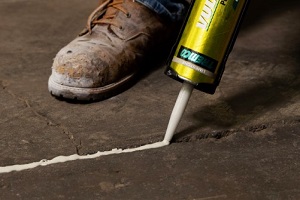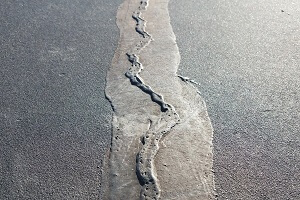 Commercial waterproof caulking keeps moisture from intruding into areas where it does not belong. It can be applied in a variety of places and substrates, including wood, tile and even masonry products like bricks and concrete. However, caulking concrete is not something that many people are aware is possible; after all, mortar is usually the sealant and bonder of choice.
Commercial waterproof caulking keeps moisture from intruding into areas where it does not belong. It can be applied in a variety of places and substrates, including wood, tile and even masonry products like bricks and concrete. However, caulking concrete is not something that many people are aware is possible; after all, mortar is usually the sealant and bonder of choice.
Still, there are circumstances in which concrete should be caulked to make it waterproof, and because this task is less common, it is easy for a DIYer or inexperienced contractor to make a mistake. Here is what you should know about how caulk interacts with concrete, as well as some tips for applying commercial waterproofing caulk on concrete the right way.
Why Caulk Concrete?
Caulk is not the same thing as mortar, though they accomplish similar jobs. Both keep water out of concrete by creating a seal. However, caulk does not perform mortar’s job of binding masonry together. Instead, caulk is flexible to ensure that it creates a seamless seal in gaps and cracks.
For that reason, caulking is only done to concrete to seal gaps that exist between the walls of a building and its foundation. It can also be used to prevent water infiltration into cracks in a building’s foundation, sealing this important structural element from gradual damage over time.
Tips for Applying Waterproof Caulking on Concrete
Completing a commercial waterproofing caulking job the right way is critical to ensure that a building’s foundation remains in good condition. If a foundation fails, it could threaten the integrity of the entire structure. In order to ensure that caulk bonds properly and keeps out moisture in critical areas of concrete, remember to follow the advice below.
Think About Adhesion
To create a robust seal that is impenetrable against water, the caulk will need to fully adhere to the concrete surface. This can be a problem if dust and debris are in the way so that the caulk cannot firmly grip the underlying concrete. Before caulk is applied, the area should be thoroughly cleaned and prepped to ensure maximum adhesion.
 Begin by brushing the dust from the concrete. This task should be completed somewhat aggressively, such as with a wire brush that will dive into the textured surface of the concrete to remove dust there as well.
Begin by brushing the dust from the concrete. This task should be completed somewhat aggressively, such as with a wire brush that will dive into the textured surface of the concrete to remove dust there as well.
Compressed air or vacuums can remove debris and dust that have been dug up by a brush. Go over the area multiple times. If there is moisture in the concrete, a flash solvent must be used to dry the surface before the caulk will adhere properly.
Wait for the Right Climate
Caulk requires an ideal temperature range in order to cure properly. Warm concrete is ideal so that the caulk can remain flexible while it dries. If caulk is applied in cold weather or while the concrete is chilled, it may not cure at the correct rate, leading to caulk that does not expand or bond as intended.
This can also result in delamination, in which the caulk releases its grip from the concrete and pulls up, exposing the surface gaps that are meant to be sealed.
Fix Problems Immediately
Caulk can prevent water intrusion when properly applied, but it cannot fix everything. If the underlying concrete surface contains sealed joints that are defective, the base surface must be repaired before the caulk can do its job.
Similarly, the area should be inspected again once the caulk has been placed to ensure that it has bonded correctly. If it is delaminating or there is an issue, the area should be redone immediately. This ensures that water intrusion is kept to a minimum and does not worsen any gaps or cracks that already exist.
Choose the Right Caulk
Caulk is a versatile material, but some types function better in specific circumstances than others. If the space is particularly moist, a polyurethane-based caulk will generally stand up to constant moisture better than silicone. Similarly, silicone cannot be painted.
Consider too whether the caulk will be exposed to chemicals that could impact its longevity or dry it out. Road salt is the most common culprit here. All of these considerations and more should go into determining the brand and variety of caulk for a project.
Trust the Pros to Get Caulking Done Right
Caulking is a preventive job to keep a building in good condition—which means that it is imperative that caulking is done right the first time, before damage occurs.
The experts at Waterproof Caulking & Restoration can help your business tackle concrete commercial waterproofing so that moisture does not cause harm to the important structural elements of your building. Contact us to learn more about the caulking work we can complete for you or to schedule an appointment to discuss your project.
